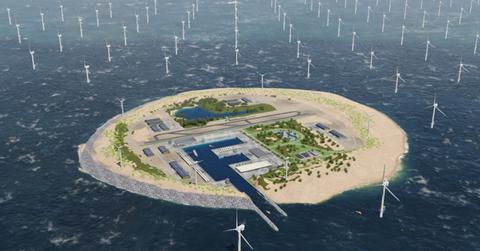Energy Company Wants To Build Entire Island For Wind Farm Off The British Coast
As locations for windfarms near coastal lines dwindle, one company is proposing an extremely ambitious solution that they say will produce more energy and save money in the long run.
Updated May 28 2019, 11:38 a.m. ET
A Dutch company called TenneT has proposed a large scale project that might completely transform how wind farms produce renewable energy. The Guardian reports that TenneT has proposed building an entire island in the North Sea, about 78 miles off the coast of East Yorkshire in the United Kingdom. The island would serve as a hub for the turbines in the ocean, with an enormous cable connecting it to the UK, the Netherlands, and eventually expanding to power Belgium, Germany, and Denmark.
The proposal is intended as a solution to land that can support windfarms filling up along the coast, and would theoretically make this energy source considerable cheaper in the area.
TenneT’s offshore wind grid development program manager, Rob van der Hage, says the island would address a vital next step in wind energy's growth.
“It’s crucial for industry to continue with the cost reduction path," said van der Hage. "The big challenge we are facing towards 2030 and 2050 is onshore wind is hampered by local opposition and nearshore is nearly full. It’s logical we are looking at areas further offshore.”
The greater the distance from a turbine to shore, the more expensive the cost of cable gets as it sends that power back to grids. With TenneT's model, the turbines would send power back to the island where it would be changed from an alternating current to a direct current, and then transmit it back to shore. Alternating current loses power over long distances, so the conversion would save it in the long run.
TenneT isn't daunted by the prospect of building an entire island in the middle of the ocean, though it would have to be five or six miles to accommodate all the needed equipment. Van der Hage joked, “Is it difficult? In the Netherlands, when we see a piece of water we want to build islands or land. We’ve been doing that for centuries. That is not the biggest challenge."
The difficulty is cost. Building the hub has an estimated price of €1.5 billion, which is apparently in TenneT's ability to pay. However, they need assistance paying for long-distance power cable. Getting partner's on board, like the British National Power Grid, means proving the ambitious project will pay for itself in time. Relatively short time.
An energy analyst at Cornwall Insight, Peter Atherton, told The Guardian that his plans to use converters was a weakness, as they're expensive and rarely used in energy infrastructure. But he agreed with TenneT's assessment that the best spots near shore are already taken. Though companies may be hesitant to sign on with such a huge project with so many unknown variables, they do seem to admit that TenneT is thinking outside the box with a solution as the need for turbines grows.
